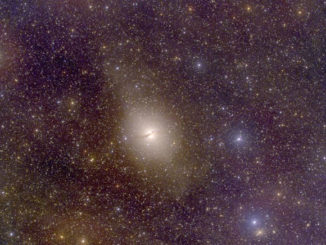The Phoenix dwarf galaxy, discovered in 1976, was originally mistaken for a globular cluster. At a distance of 1.4 million light years from Earth, it is, in fact, a dwarf galaxy, but one that defies easy classification. According to the European Southern Observatory, it does not contain enough mass for build new stars, but a cloud of nearby gas, presumably ejected by supernova explosions, seems to suggest relatively recent star formation and the presence of relatively young suns. The gas does not reside within the galaxy, but it is gravitationally connected, indicating it eventually will fall back into the dwarf. This image was captured by ESO’s Very Large Telescope using the visual and near ultraviolet FOcal Reducer and low dispersion Spectrograph, or FORS2, instrument.




